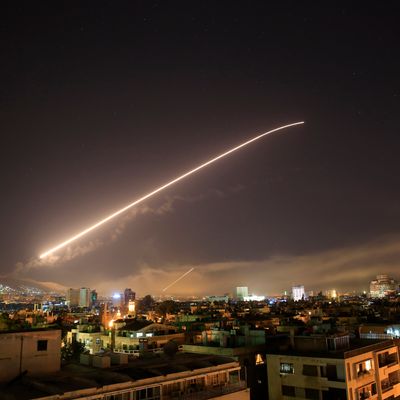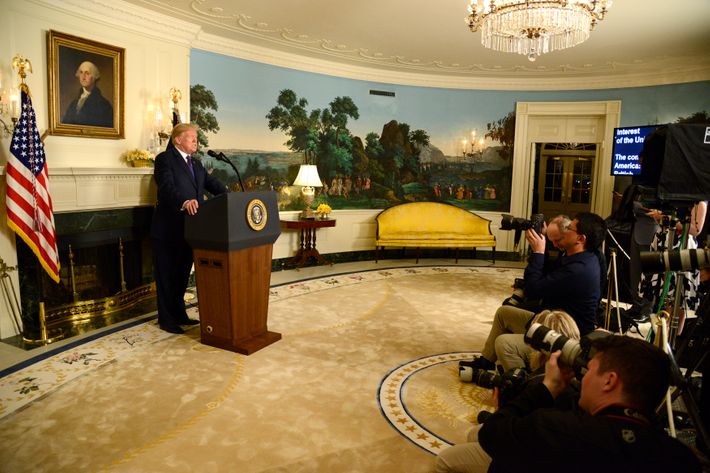
The U.S., along with Britain and France, launched airstrikes against the Assad regime in Syria on Friday night in retaliation for the alleged chemical weapon attack that killed more than 40 people in a rebel-held town a week ago. U.S. military officials said the operation targeted the regime’s chemical weapons infrastructure, striking a scientific research facility, command center, and chemical storage depot. The strikes were conducted with more than 100 long-range missiles, most of which were fired by the U.S.
President Trump announced that he had ordered the strikes in a nationally televised address on Friday night, at which point he explained that the intervention was meant to “establish a strong deterrent” against the use of chemical weapons, which he claimed was vital to U.S. national security. “The combined American, British and French response to these atrocities will integrate all instruments of our national power: military, economic and diplomatic,” Trump said. He also implied that the strikes would continue beyond Friday, as the U.S. and its allies “are prepared to sustain this response until the Syrian regime stops its use of prohibited chemical agents.”

Defense Secretary Jim Mattis, who has sought to temper Trump’s retaliatory impulses towards Syria, later explained that no further strikes on the Assad regime were planned beyond the one-night operation — unless Assad uses chemical weapons on civilians again. Mattis said that Friday’s airstrikes used roughly twice as much firepower as the strike Trump ordered against a regime airfield last year after another alleged chemical weapon attack. That retaliation was referred to as a “pinprick” strike, and seemed to have little if any effect on Assad’s military capability — though President Trump claimed on Friday that the strike had destroyed 20 percent of Syria’s air force.
It’s not yet clear how the Assad regime or its allies, Russia and Iran — who both have forces stationed inside Syria — will respond to the attack. Joseph Dunford, the chairman of the Joint Chiefs, said that Russia was not given advance notice of the strikes.
Trump specifically mentioned Russia and Iran in his address. “Russia must decide if it will continue down this dark path or if it will join with civilized nations as a force for stability and peace,” Trump said. “Hopefully, someday we’ll get along with Russia and maybe even Iran, but maybe not.”
Russia’s ambassador to the U.S. warned that there would be consequences for the attack, but Russia’s defense ministry reported that no Russia air defense systems were used to repel the attack, and did not report any injuries or damage among Russia’s forces inside Syria. One of the biggest concerns about the U.S. conducting strikes on the Assad regime has been that it could lead to military engagement between the U.S. and Russia or Iran, leading to a dangerous escalation.
Whatever happens with Iran and Russia, Trump’s decision to once again strike the Assad regime runs the risk of dragging the U.S. deeper into the already-complicated Syrian conflict, barely a week after he had said he would pull all U.S. forces out of the country. On Friday night, Trump said that the U.S. “does not seek an indefinite presence in Syria, under no circumstances.”
Trump had also teased the coming airstrikes repeatedly on Twitter over the last week, though administration officials claimed no decision had been made, and the president tried to make it seem like he was being strategically confusing.
In her own statement regarding Friday’s events, British Prime Minister Theresa May insisted that the airstrikes were not about pushing out Assad or entering Syria’s civil war, but because “we cannot allow the erosion of the international norm that prevents the use [chemical weapons].”
Last Saturday, more than 40 people were killed and more than 500 injured when an alleged chemical weapon was dropped on a building in the east Damascus suburb of Douma, which at the time was held by rebel forces opposing the Assad regime. Gruesome footage of the dead and injured, which included many children, spread quickly afterward, prompting outrage around the world, including from President Trump on Twitter. There is a lot of credible evidence that chemical weapons have been repeatedly used throughout the Syrian civil war, but there has been no definitive conclusion from an independent group on the details of the Douma attack. A UN-led investigation to confirm that a chemical agent was used, though not who used it, is set to begin on Saturday. The U.S. says it is confident a chemical agent was used in the attack, and that it was used by Assad’s forces to deliberately target civilians. The Assad regime and its allies have claimed the whole incident was a elaborate hoax.
Syrian state television confirmed that there were strikes in Damascus and Homs on Friday night, and the military lated claimed that it was able to shoot down most of the missiles. Footage of the strikes and Syrian air defenses was shared on social media:
Friday was the second time in less than a year that Trump has ordered strikes on the Assad regime in response to a suspected chemical weapon attack. The U.S. acted alone in the last attack. Neither that strike, nor Friday’s, received Congressional approval beforehand.
This is a breaking news story and this post has been repeatedly updated to reflect new information.






























